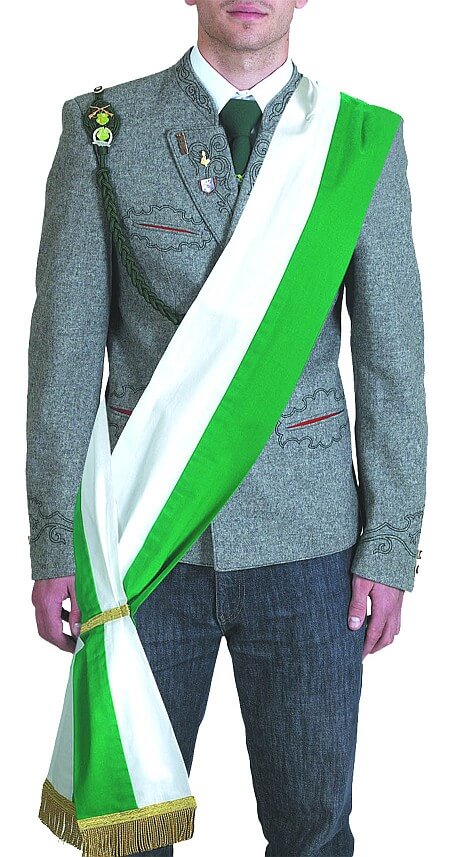The material
Since leather easily starts to mold in humid environments, which could lead to corrosion of the ammunition or weapon parts attached to it, the sashes were soon made of other materials. Cotton protected the metals better, and with the advent of plastics the problem was solved anyway. Today, nylon and other artificial fabrics are mainly used in the army.

The shoulder sash in the civilian sector
The word "sash" was borrowed from French. Scarf, armband or bodyband there is called "écharpe" and denotes a broad band that is worn with clothing. The military tradition can still be traced today, since the flag bearer and his two companions are usually marked by sashes. The bearer himself and one of the squires has a sash running from the right shoulder to the left hip, the third one from the left shoulder to the right hip. This runs through all clubs and federations, not only soldier and warrior or marksman communities. Fire brigades, traditional costume clubs or social associations also decorate their flag bearers with sashes made of velvet, rep, moire ribbon or brocade fabric. The colors depend on the club, white-blue for warriors, white-red for fire brigades and white-green for shooters.
As there are no dogmatic prescriptions about the wearing of sashes, these may also be put on differently, of course. Some club flag bearers refrain completely from wearing them, others want a symmetrical picture with four sashes.

Aldersbacher Queen of wheat beer 2019, Yvonne Wilhelm from Schöllnach
Refinement
In some regions, shoulder sashes are worn without text and motives by clubs. In Austria, however, the custom is to have the club name embroidered on. Also the organisers of beauty contests have the waistbands embroidered or printed so that the title of the winners can be seen with the respective year. Beer and wine queens often also wear embroidered sashes with vine tendrils or hop cones. The design with text and motive can be made completely according to individual tastes.
The bachelor farewell custom adopted from the USA has also caused a hype in the production of cheap paper and plastic sashes. The most important thing about these sashes is to attract attention, so that bright colors are used above all. After the event the decoration articles mostly land in the garbage. In Germany, paper sashes are seldom produced, they appear mostl in the United States.
The best material for every purpose
Decorative sashesOnly for short-term use at a birthday or bachelor party, such sashes are made of inexpensive polyester, usually printed with a slogan or a funny motif.
Easy-care sashes for associations
Sashes made of cotton are inexpensive and easy to care for. They are very hard-wearing, can be washed and ironed, but do not fall as cleanly as the sashes made of higher quality sashes.
Iridescent and printable
Moiree is a woven material which has an iridescent surface due to its wavy structure. It is easy to print on and does not need to be lined. So you can also make very stable single layer sashes. Embroidered moire sashes are additionally provided with a lining. The selection of basic colors is very large.
Iridescent and printable
With its high pile and soft feel, velvet is one of the most popular fabrics used to make sashes. It is easy to embroider and looks noble and high-quality, especially when used for honorable events. Possible soiling can be easily removed by professional cleaning.
Special materials
Sashes in the higher price segment can also be produced for extraordinary distinctions and events. Damask looks very noble due to its structure. Also flag rep is interesting due to its iridescent surface and offers a high-quality alternative to cotton or velvet.

 English
English  Deutsch
Deutsch 